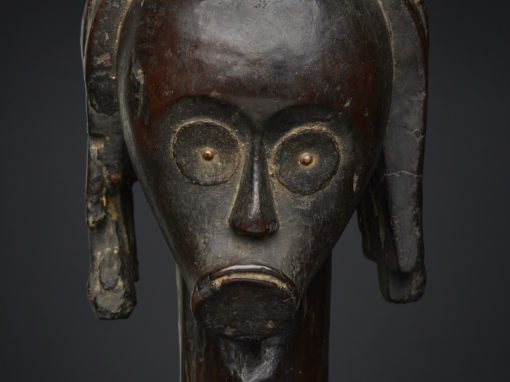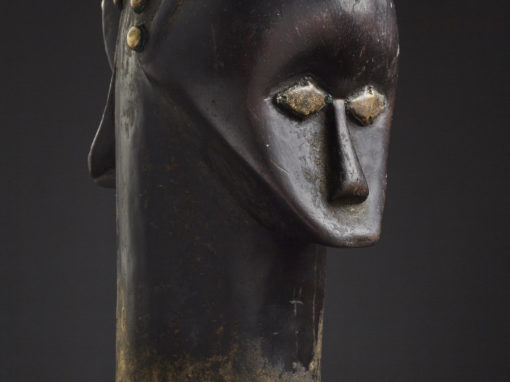
FANG „Nzaman“ reliquary head („NLO BYERI”), Tête de reliquaire
FANG HEAD (gabon), TÊTE FANG D’ANCÊTRE,
origin: equatorial forrest, africa
region: Gabon, Okano-, Abanga-River & Ogooué Valley area
age : XIX / XX century
object: „NLO BYERI“ or „EYEMA BYERI“(image of the ancestor) Fang „Nzaman Betsi“ reliquary head (to be garding „nsek byeri“)
size / material: hight 24,0 cm (9,44 inch) / Face cheek to cheek 10,0 cm (3,93 inch) / head braid to braid ca. 13,0 cm (5,11 inch) / deep ca. 12,5 cm (4,92 inch) / neck 5,5 cm (2,16 inch) / wood with patine, copper nails, iron nail, iron wire
The Fang head in this collection features striking characteristics in form and craft with some of the most iconic Fang heads known today. Three evenly spaced tresses of hair extended as broad bands back and away from the head. If watched from the front the face is framed by the outer two, while seen from the side they evoke undulating ribbons that instill this solid form with an ethereal quality that reminds us of the fang head once owned by Helena Rubinstein (excerpt from „Eternal Ancestors – the art of the central african reliquary“, museum of modern art, page 204).
In addition similar to the Vlaminck-Périnet Fang head this head is sculpted magnificently and fine showing long curves starting at the nostrils continuing to the corner of each outer eyelid. Beneath is a perfectly ovoid forehead, with a beautiful, heart-shaped face that shows grained wood closely related to ebony. Its soft deep brown and black patina suggest a significant and long traditional use over decades (excerpt from „Grandeur and Immobility“- A Byeri among the Fauves by Bernard Dulon, Sothebys Collection Michel Périnet)
The byeri cult was a cult among the Fang that honored ancestral spirits. In a broad sense, the word “byeri” means “ancestor” and figures with the same name were made to be placed on the bark boxes called „nsek-byeri“ that contained the skull(s) of an important family member(s) (man or woman). Very few people were allowed to see the contents of the nsek-byeri and the privilege was usually given to one of the mature sons of the family
who is given the responsibility of caring for the byeri objects and maintaining proper rituals. Non-family members were never allowed to see the contents of the nsek-byeri.
The reliquary boxes were kept in a special room in the house and only opened on special occasion. The sculpted byeri figures or heads served as a guardian to frighten away intruders. The figures generally represented the collective dead of the family instead of representing any one particular family member.
From 1930 on (post colonial) traditional Fang religion and art underwent a drastic transformation, until byeri figures were no longer made and their cult no longer maintained. (Text References – African Aesthetics)
„It is tempting for historians of African art to place the various Fang sub-styles and the types of objects they produced within a chronological perspective, notably when it comes to solitary heads. Given the present state of our knowledge, this is a most hazardous exercise. The historical precedence presumed for these heads as compared to whole byeri figurettes, is unfounded. One has simply noted that the majority of such heads that are known and documented, come from the right bank of the Ogowe River, in its middle course, in the regions of Abanga, Okano and the Gabon estuary. No head has been localized further to the north, that is, in south Cameroun. One may suppose that at least in the nineteenth century, solitary heads coexisted with full-size statuettes in many Betsi and Nzaman villages of the Ogooué Valley area.
Certain of these heads have a very characteristic coiffure, with a „helmet of tresses“ of geometric design such as this by indication very old head, framing the face with a markedly domed forehead, very precisely recalling the hairpieces always worn by both men and women, made from rattan and vegetal wadding, and decorated with cowries, glass beads, and often with shirt buttons of European making (afakh or nlo o ngo). The Fang heads, certain of them important masterpieces, are often particularly finely sculpted works, in contrast to the figurettes whose subsidiary parts (hands, feet, sometimes limbs) are often left in an sketchy state, with only the upper-body occupying much of the sculptor’s concern. (Text reference – L. Perrois)
This exceptional and rare „fang head“ of the „Nzaman Betsi“ substyle was found and sold to the collection by Mr. Issah Mbohou, Bruxelles.







